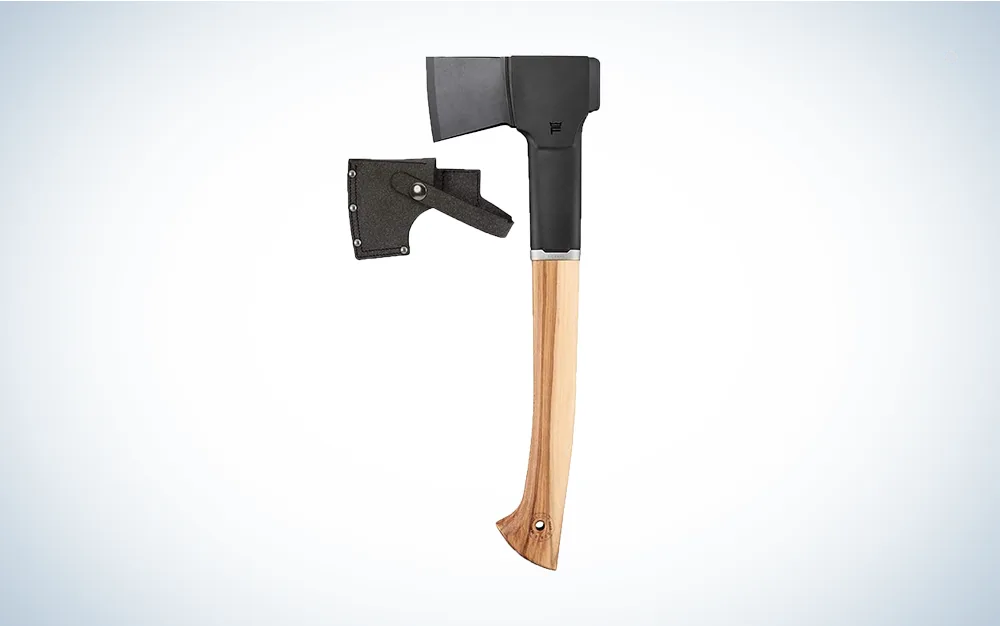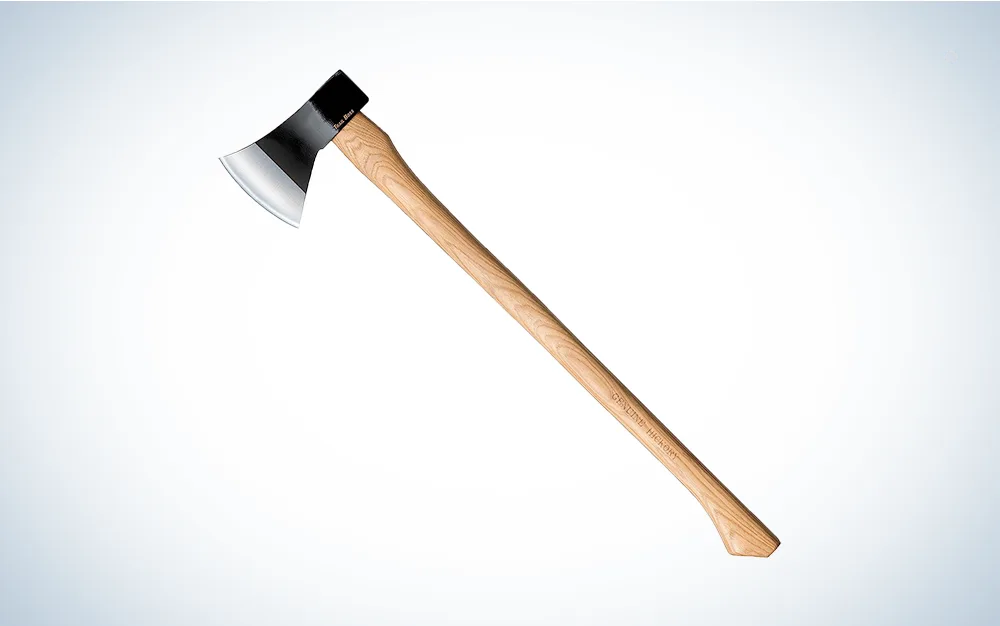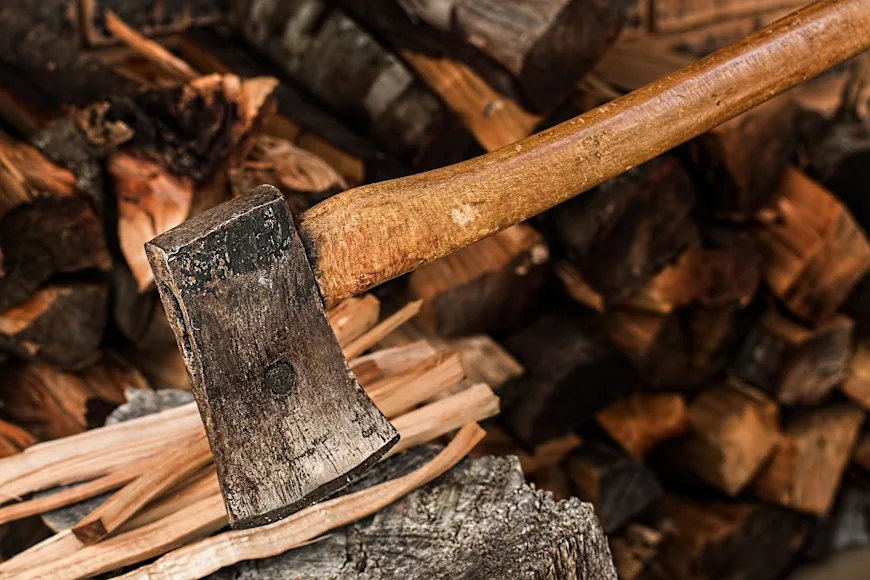_We may earn revenue from the products available on this page and participate in affiliate programs. Learn more ›
_
Best Overall

Gränsfors Bruk Large Splitting Axe
Best Budget

Eletorot Camping Hatchet
Best Lightweight

Fiskars Norden N10
Splitting wood for the coming winter isn’t just great exercise. It can be a time for reflection and even meditation. There is something deeply satisfying in seeing the pile of split wood grow larger as you work throughout the year, and in knowing that you’re getting better prepared for the cold months ahead.
That said, your enjoyment of the chore will be dramatically affected by the tools you choose. If your axe isn’t well-suited for the task at hand, you’ll struggle to make any progress and begin to dread heading to the woodpile. Even worse, you could end up ill-prepared once the snow starts to fly because you weren’t able to work efficiently.
But the right axe for splitting wood can prevent all of that. One with a comfortable and ergonomic handle, heavy head, and sharp blade will make the job much more efficient and enjoyable. But how do you know what axes are suited for splitting wood? Don’t worry. We rounded up the best of the best so you can find the right axe for splitting wood and other tasks you may encounter.
Best Overall: Gränsfors Bruk Large Splitting Axe
Best Budget: Eletorot Camping Hatchet
Best for Camping: Estwing Fireside Friend Axe
Best Multipurpose: Cold Steel Trail Boss Axe
Best for Safety: Kindling Cracker XL
Best Lightweight: Fiskars Norden N10
Best Small: Fiskars X11
Best Large: Fiskars X27 Super Splitting Axe
How We Picked the Best Axes for Splitting Wood
Growing up in Wisconsin, the cold winters test your resiliency. And when the mercury plummets below zero, keeping your home warm can be challenging. So, when I bought a house nearly 30 years ago, a wood burning stove was a must. We have a gas furnace, but the stove kicks out an amazing amount of heat, allowing us to dial the thermostat down even during bitter-cold spells and save a little money. However, this all hinges on having enough split wood to last through the winter, which means many hours spent swinging an axe in the backyard.
Over the last three decades, I’ve owned and tested numerous axes—many of which are listed below. I learned along the way what works and what doesn’t. I like a traditional wooden handle, a heavy head, and a durable leather sheath. Those are the basic requirements for any axe I use to split wood. Of course, there are other handle materials, blade sizes, build differences, and small features that can be useful. But after hundreds of hours splitting wood over the years, I always go back to my hickory handle and heavy blade.
I included other recommendations for different scenarios and pursuits, like axes for camping, budget-friendly choices, hatchets, and lightweight models. Each axe featured here was chosen because they get the job done, pure and simple. I know because I’ve used them. And after years spent in the yard swinging an axe, this is what I recommend.

Image by Karsten Paulick from Pixabay
Best Axes for Splitting Wood: Reviews and Recommendations
Best Overall: Gränsfors Bruk Large Splitting Axe

Specs
Weight: 5.3 pounds
Length: 27.56 inches
Cutting edge: 3.0 inches
Pros
Durable and comfortable in the hand
Steel collar protects handle from accidental impacts
Wood handle is easy to replace if needed
Well-known company with a solid reputation
Cons
Expensive
Gränsfors Bruk has been making axes for over 100 years, and in that time, they’ve developed an absolutely stellar reputation for quality. Every axe is designed for real world use and handmade to exacting specifications. The Large Splitting Axe has a forged head that bears a very thin, sharp concave edge. It bites deep and quickly separates the wood fibers. The wooden handle is strong and absorbs shocks fairly well. There’s a steel collar just behind the head to protect the handle from accidental misses, adding to the overall durability of the axe. And while this is the most expensive axe on the list, it will last season after season, no questions asked. It also comes with a handsome leather sheath to complete the package.
Best Budget: Eletorot Camping Hatchet

Specs
Weight: 1.76 pounds
Length: 14.5 inches
Cutting edge: 3.3 inches
Pros
Compact at just 14 inches long
Easy to store
Can also be used for clearing trails and similar chores
The hickory handle is ergonomic and comfortable
Cons
Will need to be sharpened before using it for the first time
A small hand axe or hatchet like this isn’t an ideal tool for splitting wood. But not everyone can drop a hundred bucks on a good axe, so compromises need to be made. This one will do the job, and do it surprisingly well for its size. It is well-balanced and easy to use. The downside is that it isn’t large enough to handle heavy-duty tasks. Think more along the lines of splitting kindling than large logs.
Eletorot lists this as a “camping hatchet,” and that is an accurate description. The compact size and lightweight design make this an ideal tool to have at camp for splitting small pieces of wood and kindling, hammering in stakes, cutting rope, or any other camp tasks. It is also the perfect size to keep in your truck for emergency situations.
Best for Camping: Estwing Fireside Friend Axe

Specs
Weight: 7.05 ounces
Length: 14.25 inches
Cutting edge: 2.375 inches
Pros
Durable one-piece construction
Includes a ballistic nylon sheath to protect the edge
The grip is made from hand-sanded genuine leather
Cons
A little top-heavy and awkward until you’re used to it
Estwing is known for producing quality hand tools, and this is no exception. The Fireside Friend Axe is made from a solid piece of steel, resulting in incredible durability. It’s shaped sort of like a miniature splitting maul, and it will get the job done without taking up too much space. They also added a leather grip for comfort. In fact, this grip will absorb a significant amount of impact shock as you work, leaving you less tired after the job is done.
The wedge-shaped head is weighted, so it will lend extra power to each swing, despite its small size. It is just over 14 inches long and will fit into virtually any camping pack. It is also just long enough to use with either a one- or two-handed grip.
Best Multipurpose: Cold Steel Trail Boss Axe

Specs
Weight: 2.59 pounds
Length: 27.0 inches
Cutting edge: 4.5 inches
Pros
Large 4.5-inch cutting edge
Straight-grained American Hickory handle
Total weight is less than three pounds
Cons
Carbon steel head can be prone to rusting if neglected
While splitting wood is one of the primary uses of an axe, sometimes you want something that will do more, so as to reduce the number of tools you need to bring. This axe from Cold Steel works great for splitting as well as for chopping kindling, clearing storm debris, and even felling trees in a pinch. Its straight handle is made from American Hickory, so you know it’ll last a long time. The drop-forged 1055 steel head has a generous 4.5-inch cutting blade that makes splitting wood a breeze. From end to end, this axe stretches 27 inches, so it’ll be long enough to tackle any chore without being a burden to bring along or mount in the bed of your truck.
Best for Safety: Kindling Cracker XL

Specs
Weight: 21.3 pounds
Length: 17.0 inches
Cutting edge: 9.0 inches
Pros
Safest option on the market for splitting wood
The feet can be bolted to a work surface for increased stability
Can be used indoors or outdoors
Cons
Hard to sharpen, if needed
Okay, this one isn’t really an axe, but it is absolutely the safest way to split wood. The process is simple and effective. Place the wood into the ring, then use a sledge or mallet to drive the wood down into the wedge. At no time are you swinging any sharpened edge anywhere, so there’s little risk of injury.
Its 9-inch diameter ring and 17-inch height allow you to process large pieces of wood quickly, getting the job done sooner so you can get back to doing the fun stuff. Cast iron construction means this handy tool is virtually maintenance-free, too. You can even mount it to a work surface for absolute stability, which will also improve the safety and effectiveness of the Cracker XL.
Best Lightweight: Fiskars Norden N10

Specs
Weight: 1.85 pounds
Length: 17.0 inches
Cutting edge: 2.87 inches
Pros
All Fiskars axes come with a lifetime warranty
A sheath made from recycled leather is provided
The carbon steel head isn’t hard to sharpen in the field
Cons
Not made to handle large logs or rounds
A lightweight splitting axe is something of a misnomer because you usually want some weight behind the swing to effectively split the wood. That said, there’s weight, and there’s weight. The heavier the axe is, the harder you’ll end up working to swing it over and over. The Norden N10 hits a nice middle ground where it is robust enough to do the work without being so heavy that you’ll tire easily.
The hickory handle has a FiberComp overlay collar to provide protection against damage from overstrikes. It is 17 inches long, giving you plenty of reach. It is also a good option for someone looking to toss it in their pack, only weighing 1.85 pounds.
Best Small: Fiskars X11

Specs
Weight: 2.18 pounds
Length: 17.0 inches
Cutting edge: 2.5 inches (approx.)
Pros
Short, so it won’t take up too much pack space
Textured, non-slip grip for safety as well as comfort
Designed for one-hand use
Cons
Not large enough for heavy-duty use
You don’t want to be weighed down by a ton of gear on a camping trip. And while you can probably make do when it comes to firewood for a day or two by scrounging sticks together, you’ll want a reliable firewood processing tool for longer stays. Sure, you could use your knife to baton firewood into size, but that’s not the best option
. That’s where the Fiskars X11 comes into play. At just a bit more than two pounds, it is easy to pack and carry, even on lengthy treks into the wilderness.
The X11 has a low-friction coating on the wedge-shaped head, allowing it to easily slide through the wood it splits. The FiberComp handle is virtually impossible to break, and thus rather forgiving to the budding lumberjack. It also features an optimized power-to-weight ratio, increasing your swing speed effortlessly.
Best Large: Fiskars X27 Super Splitting Axe

Specs
Weight: 5.85 pounds
Length: 36.0 inches
Cutting edge: N/A
Pros
Shock-absorbing handle has a textured, non-slip grip
A full 36-inch length makes it perfect for tall users
Great value
Cons
Might be a bit too much axe for some people
This axe is a monster, but handles like a dream. It is designed for splitting medium and large logs and will do so with one strike quite often. The advanced bevel convex design of the head means efficient splitting as well as easy removal from the wood. On top of that, the handle absorbs shocks with every swing. The overall length is three feet, and it weighs in at 5.58 pounds. This is no backpacker’s axe. It is made for home or worksite use. A sheath is included, and the axe is covered by a lifetime warranty.

The right-sized axe can make slitting wood much easier. Image by Helge Ely from Pixabay
Things to Consider Before Buying an Axe
come in a variety of shapes and sizes. Some are designed for strictly splitting big logs, some are made to carry with you camping, and others offer more versatility. We took into account the purpose of each axe and the different scenarios you might find yourself splitting wood. But remember to also consider these factors before buying your next axe.
Handle and Head
Handle material is important. Personally, I prefer a wooden handle, preferably American Hickory. Admittedly, there’s something to be said for a composite handle, but wood is traditional as well as comfortable.
How well an axe head works is due to a few factors. The shape is certainly a consideration, which would include how keen the edge is on the blade. The sharper it is, the easier your job will be. The slope or angle of the cheeks, which are the sides of the axe head, will also impact this to some degree. You want them to quickly slide the wood apart once the edge digs into the material.
Weight
The heads of the axes above tend to be on the heavy side, with a weight averaging between three and six pounds. Splitting wood requires a fair bit of force, and the lighter the axe is, the more effort you’ll need to exert to move the axe head through the material. A heavier axe head requires less of your energy to split the wood, but if it is too heavy to lift and swing comfortably, it can be dangerous. You need to find a balance between an axe that’s heavy enough to do the work while not being so heavy that you can’t control it.
Blade Materials
The steel used is also important. Some sort of carbon steel is common, as you can sharpen it easily in the field, and it will keep that edge for a while. The last thing you want is to touch up the blade after every couple of swings. However, carbon steel does tend to rust if it isn’t cared for properly, so regular maintenance is required.
FAQs
Q: Is a dull axe better for splitting wood?
President Abraham Lincoln famously said, “Give me six hours to chop down a tree and I will spend the first four sharpening the axe.” With any sort of cutting task, the sharper the tool, the easier the work. Not only that, but a sharp tool is safer to use. If the axe is dull, you’ll need to exert more force to move it through the wood, which increases the likelihood of a slip and an accident. Fortunately, sharpening an axe
isn’t difficult, though it does take some practice.
Q: What is the best axe length?
Here’s how to determine the best axe length for your body. Hold the axe in your dominant hand, gripping it just behind the head, and extend your arm straight in front of you. Rotate the handle up, toward your body. An axe of the proper length will have the handle just reach your armpit.
Q: How long should you wait to split wood?
Wood can and should be split soon after it has been cut to length. Green wood is easier to split than seasoned. Plus, split wood will dry and season quicker than full pieces. It could take upwards of a year for whole pieces to fully dry, whereas splitting the wood can cut that time in half.
Best Axes for Splitting Wood: Final Thoughts
Best Overall: Gränsfors Bruk Large Splitting Axe
Best Budget: Eletorot Camping Hatchet
Best for Camping: Estwing Fireside Friend Axe
Best Multipurpose: Cold Steel Trail Boss Axe
Best for Safety: Kindling Cracker XL
Best Lightweight: Fiskars Norden N10
Best Small: Fiskars X11
Best Large: Fiskars X27 Super Splitting Axe
Like any other tool, a splitting axe is designed for a specific purpose. It is not recommended that you use one as a wedge, or for striking a wedge, for that matter. It isn’t a splitting maul, though some models might bear a passing resemblance to one. For those unfamiliar with the differences between an axe and a maul, the former has a sharp edge that will bite deeply into the wood, whereas the latter is heavier and relies more on brute strength to power through the wood.
The splitting axe is also more than a bit different than the venerable tomahawk
. While the ‘hawk will do fine with smaller, thinner bits of wood, you’ll struggle to split anything of medium or large size.
Use a splitting axe to process firewood by splitting pieces along the grain. Trying to split wood across the grain is a losing proposition. Any of the axes featured here will do the job efficiently, allowing you to move on to other chores that need attention before winter hits.
Why Trust Us
For more than 125 years, Field & Stream has been providing readers with honest and authentic coverage of outdoor gear. Our writers and editors eat, sleep, and breathe the outdoors, and that passion comes through in our product reviews. You can count on F&S to keep you up to date on the best new gear. And when we write about a product—whether it’s a bass lure or a backpack—we cover the good and the bad, so you know exactly what to expect before you decide to make a purchase.






